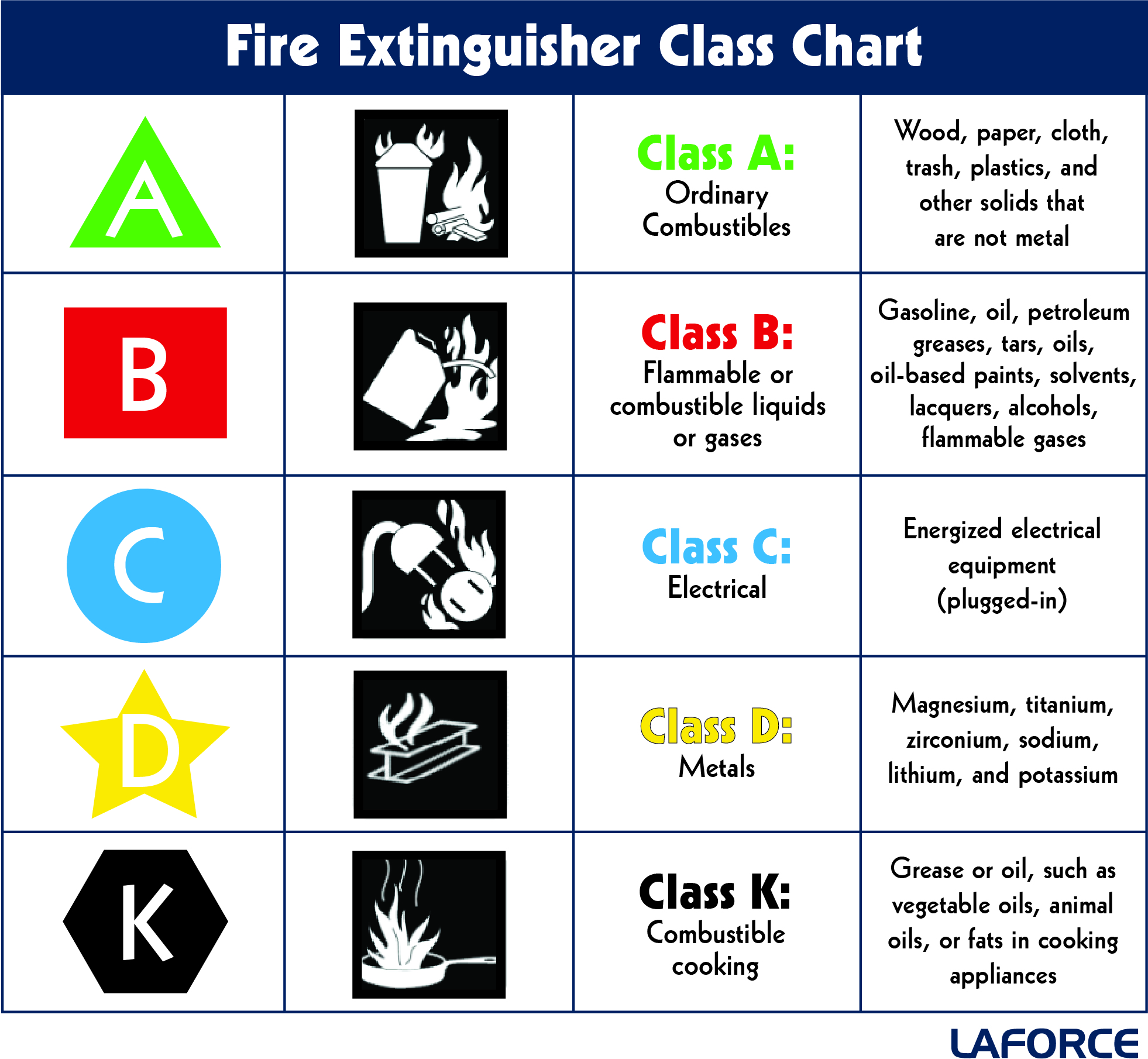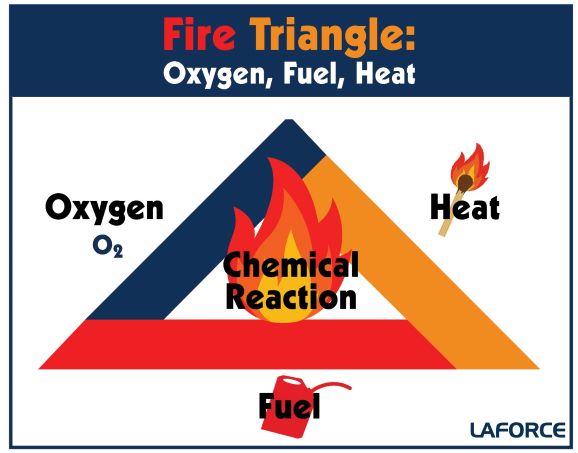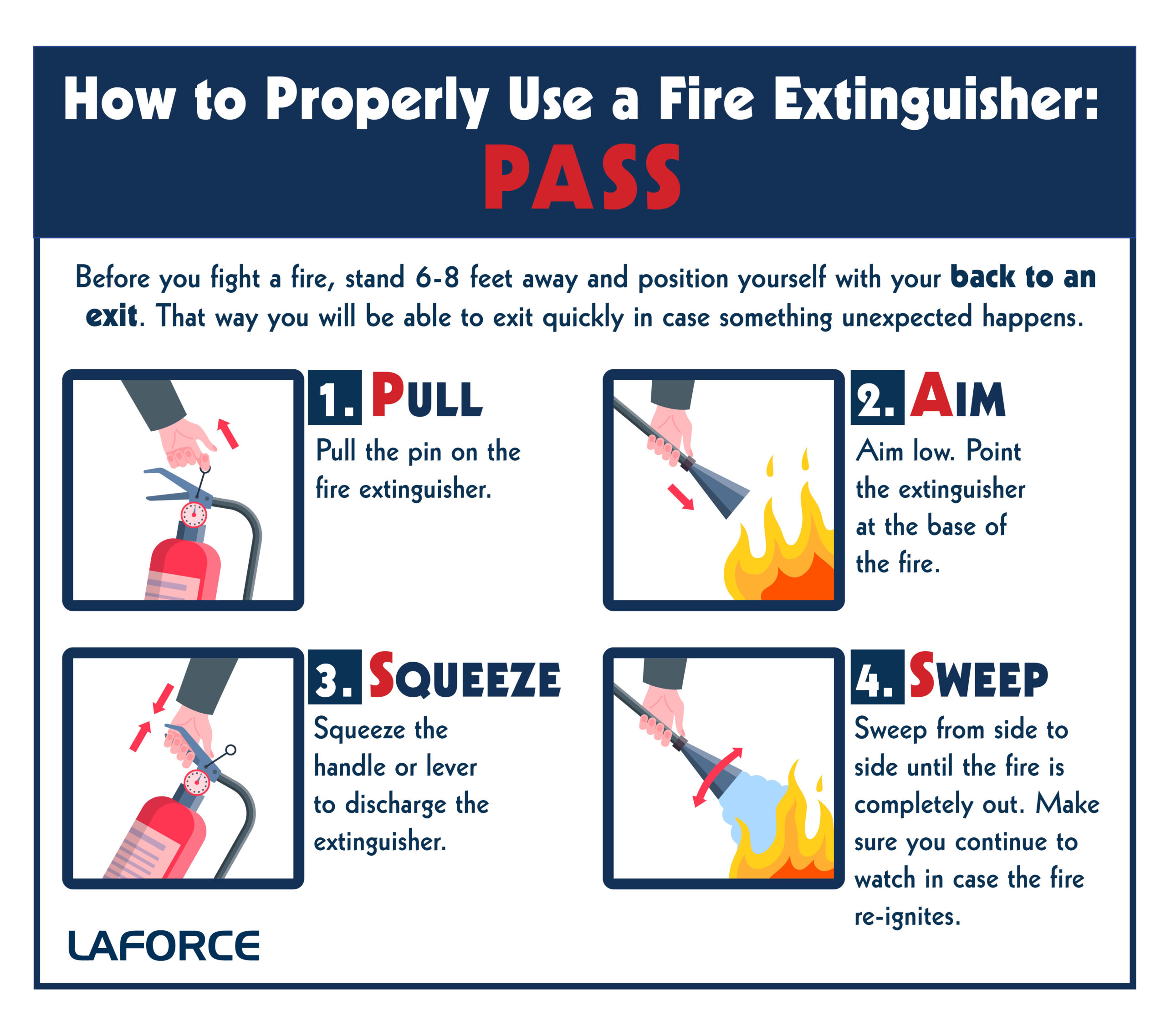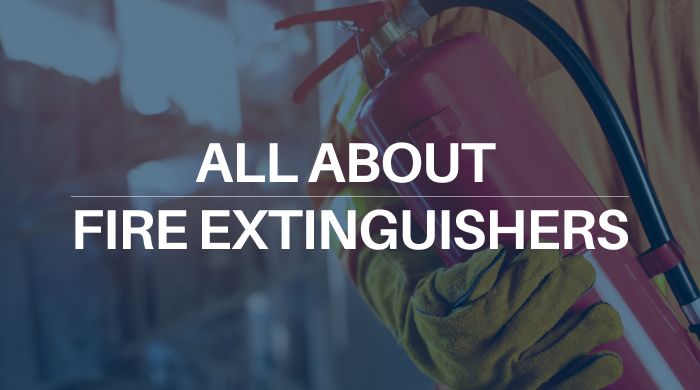Fire extinguishers can be a life-saving tool for small fires, but there are important things to know. Such as how to properly use a fire extinguisher and ensuring that you have the correct fire extinguisher for your facility.
First of all, when a fire is discovered immediately call 911 and activate the building alarms, as well as assist anyone that may be in danger (without putting yourself in danger).
You should NOT try to contain a fire with a fire extinguisher if:
- You do not know what is burning.
- You do not know how to use a fire extinguisher.
- It is generating a substantial amount of smoke.
- The fire is near other flammable/combustible materials or may produce toxic fumes.
- The fire is too large to handle with one fire extinguisher.
- The fire could cut off your escape route.
Prepare for a Fire Emergency!
- Do you have an evacuation plan? Make sure you have an evacuation plan in place and review/practice it at least once a year. Remember to close doors and windows as you evacuate to help stop the spread of fire.
- Do you know the location of the nearest fire extinguisher? According to OSHA, the travel distance to an extinguisher cannot exceed 75 feet (for Class A hazards). In occupancies using flammable or combustible liquids (Class B hazards), travel distance to an extinguisher cannot exceed 50 feet. Certain spaces or buildings such as manufacturing facilities may have additional requirements that should be evaluated by an expert.
- Do you know what type of fire the fire extinguisher can be used for? If you use the wrong fire extinguisher you risk making the situation worse! See the chart below for a quick reference.
- Do you know how to properly use a fire extinguisher? “PASS” is what you need to remember, read on to learn more.
Note: Fire extinguishers can expire! Each type of extinguisher and brand have different expiration dates so make sure to check your manual.
What do the Symbols on a Fire Extinguisher Mean?
All fire extinguishers are labeled with a letter or symbol that indicates what type of fire the fire extinguisher can be used for. These Classes are A, B, C, D, or K classes. Some extinguishers have a “multi-purpose” rating which is a combination of these symbols, such as AB, BC, or ABC, which simply means that those types of fire extinguishers can be used on multiple types of fire.
Class A Fire Extinguishers: Ordinary combustibles – wood, paper, cloth, trash, plastics, and other solids that are not metal.
Class B Fire Extinguishers: Flammable or combustible liquids or gases – gasoline, oil, petroleum greases, tars, oils, oil-based paints, solvents, lacquers, alcohols, and flammable gases.
Class C Fire Extinguishers: Electrical – energized (plugged-in) electrical equipment.
Class D Fire Extinguishers: Metals – magnesium, titanium, zirconium, sodium, lithium, and potassium. These types of fires require special extinguishing agents. These fire extinguishers are not given a multi-purpose rating to be used on other types of fires.
Class K Fire Extinguishers: Combustible cooking – grease or oil, such as vegetable oils, animal oils, or fats in cooking appliances. This type of fire extinguisher discharges a fine mist which helps prevent grease splash and fire reflash while also cooling the appliance.

For more information about fire extinguisher symbols visit NFPA.
Fire Triangle: Oxygen, Fuel, Heat

Starting with the very basics, you need to understand that in order for a fire to burn it needs three elements: oxygen, heat and fuel (or combustible material). If you remove one of these elements, then the fire will be extinguished. Fire extinguishers are designed to help remove one of these elements to put out the fire.
The Most Common Fire Extinguishers LaForce Provides are:
- Multi-Purpose Dry Chemical Fire Extinguishers: These types of fire extinguishers contain specially fluidized and siliconized mono ammonium phosphate powder which smothers and breaks the chain reaction on Class B fires, fuses and insulates Class A fires, and, as a non-conductor of electricity, is effective on Class C fires.
- Class K Wet Chemical Fire Extinguishers: These fire extinguishers are recommended for commercial restaurant applications. They contain a low “pH” potassium acetate and potassium citrate solution that is discharged in a fine mist and provides an excellent range while cooling the fire and preventing splashing of liquid cooking media fires.
- Clean Agent Fire Extinguishers: These types of extinguishers are called “clean agent” because they leave no residue and are EPA approved. This agent discharges as a liquid, then quickly evaporates, leaving no residue to clean up afterwards. Clean agent extinguishers are primarily for Class B & C fires and since they are electrically non-conductive, they are a popular choice when trying to save electrical equipment.
(Reference: Larsen’s and JL Industries)
How to Use a Fire Extinguisher: PASS
It’s easy to to use a fire extinguisher if you can remember the acronym PASS, which stands for Pull, Aim, Squeeze, and Sweep. Most portable fire extinguishers work according to these directions, but it is always important to read the manual for your fire extinguisher.
Before you fight a fire, stand 6-8 feet away and position yourself with your back to an exit. That way you will be able to exit quickly in case something unexpected happens.
- PULL the pin on the fire extinguisher.
- AIM low. Point the extinguisher at the base of the fire.
- SQUEEZE the handle or lever to discharge the extinguisher.
- SWEEP from side to side until the fire is completely out. Make sure you continue to watch in case the fire re-ignites.

What Type of Fire Extinguisher Is Right for Your Facility?
- Determine the fire hazards and materials: Different areas of your building may have different fire hazards. Evaluate each area such as kitchens, manufacturing areas (be sure to check for combustible materials!), storage closets, electrical closets, etc.
- Room size: A smaller area would need a smaller fire extinguisher compared to a larger area.
- Weight of the fire extinguisher: Fire extinguishers can have different weights. Make sure that the weight of the first extinguisher is not too heavy for your occupants to use.
Overall, the best way to keep yourself and your facility safe in the event of a fire is to be prepared. Take time to review your evacuation plans, understand how to use a fire extinguisher, and make sure your occupants know the location of the nearest fire extinguisher.
At LaForce, our Building Specialties experts can assist you with ordering the correct fire extinguisher for your facility, along with the correct cabinet for safe keeping. Contact us today!



Follow Us